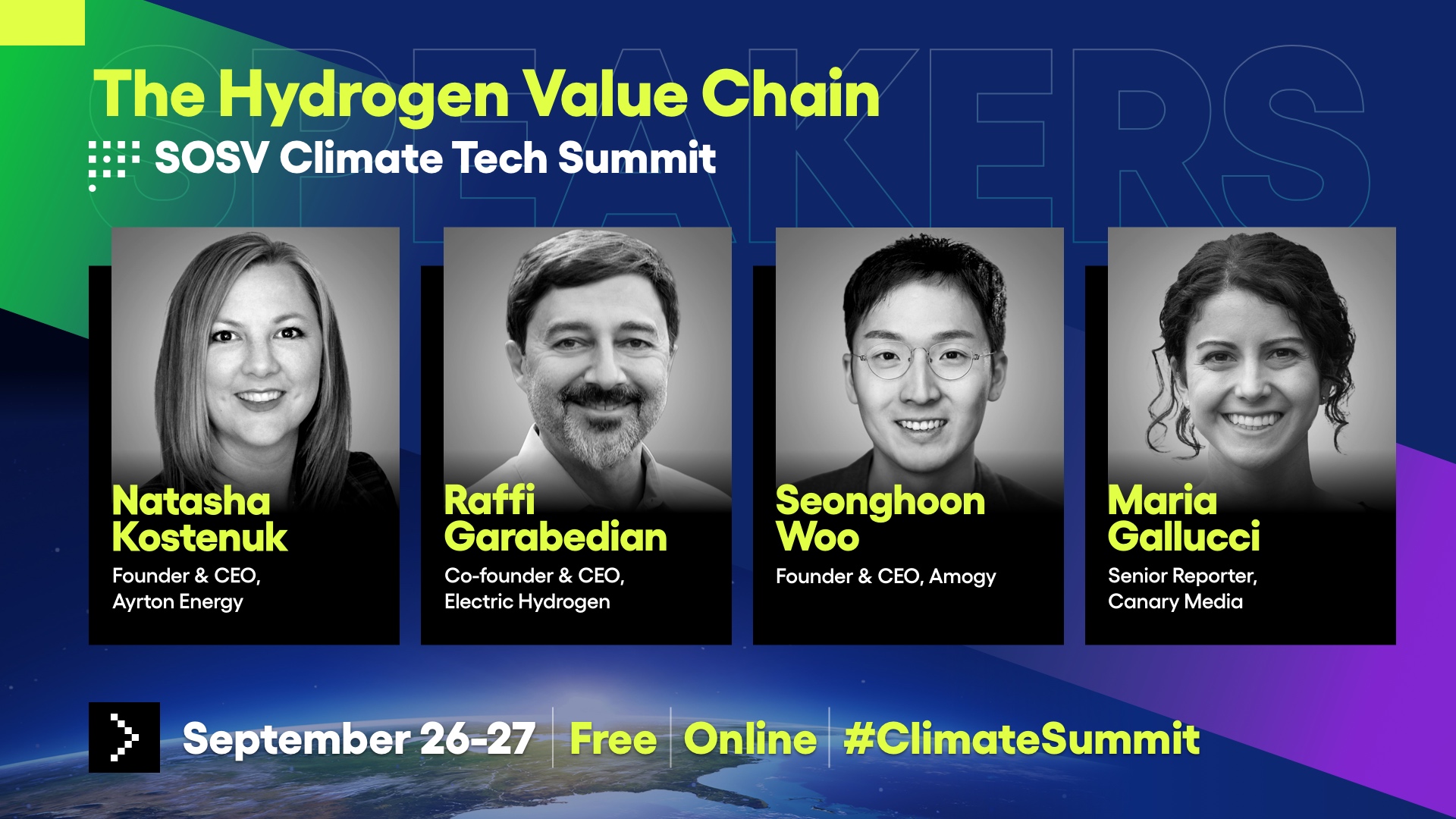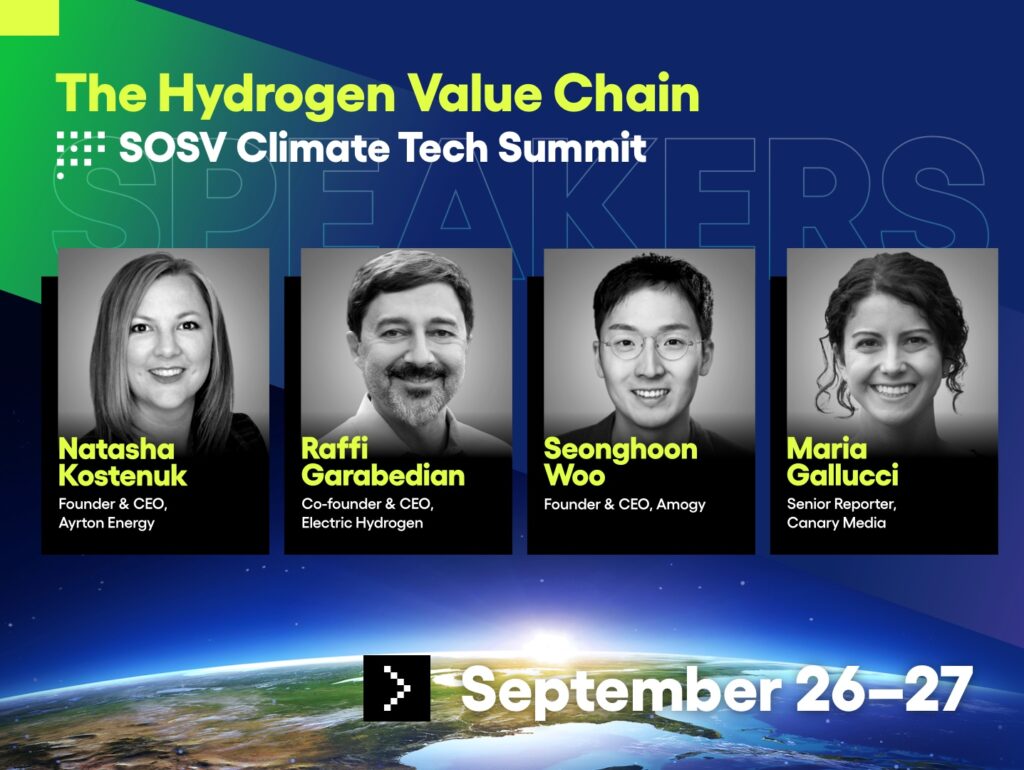
Hydrogen is a promising but finicky energy carrier with the potential to decarbonize steelmaking, ocean shipping, chemical manufacturing, and more. However, the universe’s most abundant element can be inefficient and dangerous, and “hydrogen economy” hype has fizzled many times before. At the SOSV Climate Tech Summit (Sept 26-27 / free & virtual), we met three entrepreneurs who aim to address hydrogen’s drawbacks and put it to work against climate change.
The biggest challenge with hydrogen is efficiency. Unfortunately, hydrogen is so reactive that it rarely exists freely on Earth and must be generated by various means, each designated by a “color” indicating how carbon intensive the process is. The most common method, steam methane reforming (SMR), makes methane (aka, natural gas or CH₄) react with steam and emits 8 kg-10 kg of CO2 per kg of H2. This “gray hydrogen” is typically used in ammonia and fertilizer manufacturing, oil refining, and other chemical processes. Climate technologists hope to shift the bulk of production to emission-free “green hydrogen” by using renewable electricity to split water (H2O) via electrolysis.
The most pressing issue for green hydrogen is forthcoming guidance from the U.S. Department of the Treasury on how to interpret the Inflation Reduction Act’s (IRA) 45V Hydrogen Production Tax Credit, which awards up to $3 per kilogram of hydrogen produced. Forging rules could reward hydrogen production methods that generate more greenhouse gas emissions than steam methane reforming. Conversely, tight rules could disqualify many hydrogen innovators from the 45V credit and smother the industry.
Even if the 45V credit were to make green hydrogen cost-competitive with dirtier fuels, barriers remain. Energy analyst Michael Liebreich, founder of BloombergNEF, estimates that to go from gray to green while meeting current hydrogen demand we’d need 143% of the world’s installed solar and wind capacity. Thus, some hydrogen startups hope to drill for “gold hydrogen” deep underground, where water-rock reactions continuously generate a naturally occurring supply.
The other significant issue with hydrogen is transportation and storage. Hydrogen transitions from gas to liquid at -253° C (-423.4° F) and has only 30% of the energy density of natural gas, making transportation costlier in the same proportion. Moreover, hydrogen tends to make metal containers and piping brittle over time, leading to hairline cracks and the risk of leaks and Hindenburg-style explosions.
What will it take to overcome these issues and scale hydrogen? We turn to innovators in the field for answers.
Electric Hydrogen Co (EH2) is developing new electrolysis technologies to produce cost-competitive green hydrogen for heavy industries like ammonia and steel. The Massachusetts-based company has raised over $200M from investors including Breakthrough Energy Ventures, Prelude Ventures, Capricorn Investment Group, Energy Impact Partners, Fifth Wall Climate Tech, and S2G Ventures. EH2 recently announced the location of its first electrolyzer “gigafactory” in Devens, Mass. Co-founder and CEO Raffi Garabedian joined the panel.
Ayrton Energy is developing liquid organic hydrogen carrier (LOHC) storage technology to enable safe, scalable distribution of hydrogen without the need for cryogenics and pressure. Founded in 2021 in Calgary, Alberta, Ayrton participated in HAX (SOSV’s hard tech program) and is backed by investors including Hogarth Ventures, The51, and Valhalla Private Capital. Natasha Kostenuk, founder and CEO of Ayrton Energy, joined the discussion.
Brooklyn, NY-based Amogy aims to decarbonize global transportation and industry using a “Powerpack” that releases hydrogen from green ammonia (NH3) and feeds it into a fuel cell. Ammonia may be safer and easier to store than pure hydrogen, though it, too, comes with risks. Earlier this year, Amogy introduced the first ammonia-powered semi-truck and aims to demo a tugboat later this year. Founded by four PhDs with degrees from MIT, Amogy has raised over $200M from investors including Amazon’s Climate Pledge Fund, AP Ventures, SK, Saudi Aramco, and DCVC. Dr. Seonghoon Woo, founder and CEO of Amogy, represented the company.
Maria Gallucci, Senior Reporter at Canary Media, moderated the panel.
Can climate technologists unlock the full potential of hydrogen for the energy transition?
The Speakers

Raffi Garabedian
Raffi Garabedian is co-founder and CEO of Electric Hydrogen Co. Prior to Electric Hydrogen, Raffi served as chief technology officer at First Solar, Inc. (NASDAQ: FSLR) since May 2012 having joined the company in June 2008. Before First Solar, Raffi was the founding CEO of Touchdown Technologies, Inc., acquired by Agilent/Verigy, and of Micromachines Inc., which Kavlico acquired. He earned a Bachelor of Science degree in electrical engineering from Rensselaer Polytechnic Institute and a Master of Science degree in electrical engineering from the University of California Davis.

Natasha Kostenuk
Natasha Kostenuk is a professional engineer and cleantech entrepreneur with expertise in business development and technology commercialization. In 2021, Natasha founded Ayrton Energy, developing next generation hydrogen storage solutions. Natasha completed a Bachelor of Science in Mechanical Engineering at the University of Calgary before beginning her career in the oil and gas industry at an energy service company where she spent 19 years gaining a breadth of experience.

Seonghoon Woo
Seonghoon Woo is the founding CEO of Amogy, which builds zero-emission ammonia-fueled power systems to decarbonize heavy transportations focusing on global shipping. Seonghoon received his PhD from MIT in 2015 where his dissertation focused on semiconductor physics and spintronics, with a minor in Finance. He then built an academic and industrial career, including his recent work at IBM TJ Watson Research Center as a Staff Scientist prior to Amogy. He was selected as a Forbes 30 under 30 in 2018.

Maria Gallucci
Maria Gallucci is a senior clean energy reporter at Canary Media, where she covers hard-to-decarbonize sectors and efforts to make the energy transition more affordable and equitable. She was most recently a contributing writer for Grist and IEEE Spectrum, and was previously a staff reporter for InsideClimate News, Mashable, and Mexico City newspapers. Her reporting has taken her across the Americas and inside cargo ships, power plants, and nuclear waste facilities. She was the 2017-2018 Energy Journalism Fellow at the University of Texas at Austin and a 2021 TED speaker. Maria now resides in Brooklyn, New York.

